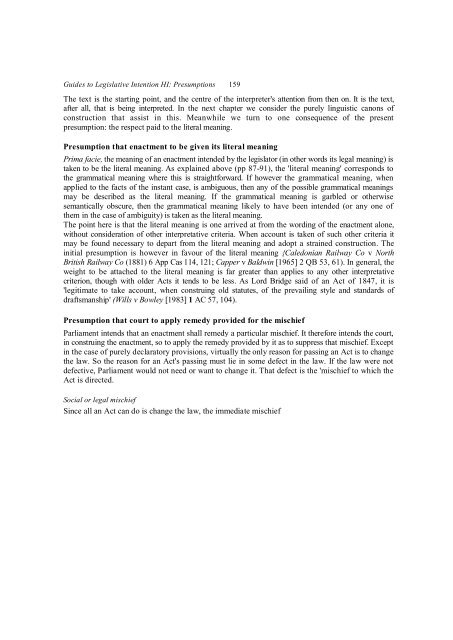Statutory Interpretation The Technique of Statutory ... - Francis Bennion
Statutory Interpretation The Technique of Statutory ... - Francis Bennion
Statutory Interpretation The Technique of Statutory ... - Francis Bennion
You also want an ePaper? Increase the reach of your titles
YUMPU automatically turns print PDFs into web optimized ePapers that Google loves.
Guides to Legislative Intention HI: Presumptions 159<br />
<strong>The</strong> text is the starting point, and the centre <strong>of</strong> the interpreter's attention from then on. It is the text,<br />
after all, that is being interpreted. In the next chapter we consider the purely linguistic canons <strong>of</strong><br />
construction that assist in this. Meanwhile we turn to one consequence <strong>of</strong> the present<br />
presumption: the respect paid to the literal meaning.<br />
Presumption that enactment to be given its literal meaning<br />
Prima facie, the meaning <strong>of</strong> an enactment intended by the legislator (in other words its legal meaning) is<br />
taken to be the literal meaning. As explained above (pp 87-91), the 'literal meaning' corresponds to<br />
the grammatical meaning where this is straightforward. If however the grammatical meaning, when<br />
applied to the facts <strong>of</strong> the instant case, is ambiguous, then any <strong>of</strong> the possible grammatical meanings<br />
may be described as the literal meaning. If the grammatical meaning is garbled or otherwise<br />
semantically obscure, then the grammatical meaning likely to have been intended (or any one <strong>of</strong><br />
them in the case <strong>of</strong> ambiguity) is taken as the literal meaning.<br />
<strong>The</strong> point here is that the literal meaning is one arrived at from the wording <strong>of</strong> the enactment alone,<br />
without consideration <strong>of</strong> other interpretative criteria. When account is taken <strong>of</strong> such other criteria it<br />
may be found necessary to depart from the literal meaning and adopt a strained construction. <strong>The</strong><br />
initial presumption is however in favour <strong>of</strong> the literal meaning {Caledonian Railway Co v North<br />
British Railway Co (1881) 6 App Cas 114, 121; Capper v Baldwin [1965] 2 QB 53, 61). In general, the<br />
weight to be attached to the literal meaning is far greater than applies to any other interpretative<br />
criterion, though with older Acts it tends to be less. As Lord Bridge said <strong>of</strong> an Act <strong>of</strong> 1847, it is<br />
'legitimate to take account, when construing old statutes, <strong>of</strong> the prevailing style and standards <strong>of</strong><br />
draftsmanship' (Wills v Bowley [1983] 1 AC 57, 104).<br />
Presumption that court to apply remedy provided for the mischief<br />
Parliament intends that an enactment shall remedy a particular mischief. It therefore intends the court,<br />
in construing the enactment, so to apply the remedy provided by it as to suppress that mischief. Except<br />
in the case <strong>of</strong> purely declaratory provisions, virtually the only reason for passing an Act is to change<br />
the law. So the reason for an Act's passing must lie in some defect in the law. If the law were not<br />
defective, Parliament would not need or want to change it. That defect is the 'mischief to which the<br />
Act is directed.<br />
Social or legal mischief<br />
Since all an Act can do is change the law, the immediate mischief

















